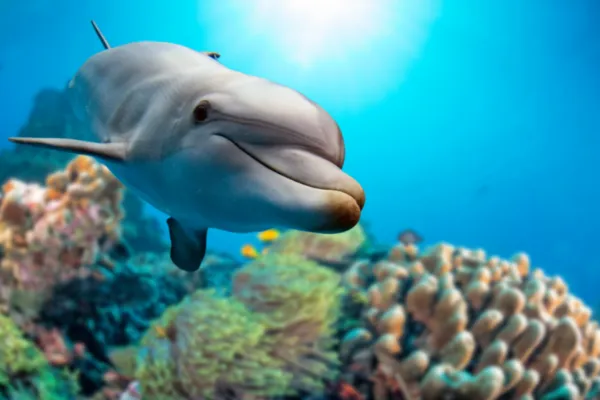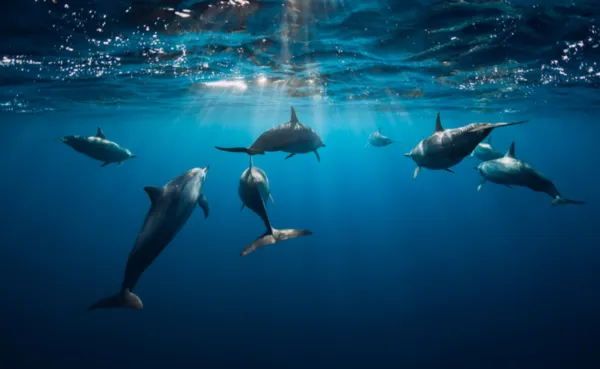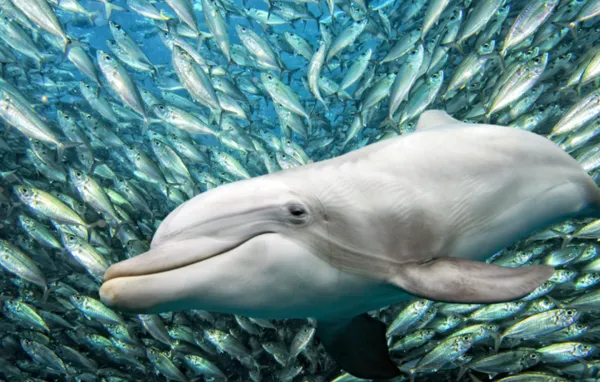dolphins.html">Dolphins are highly popular marine mammals, instantly recognizable by their naturally upturned mouths that give the impression of a permanent smile. Combined with their playful, curious, and friendly nature, they are among the most beloved ocean creatures. dolphins.html">Dolphins are found in seas and oceans all over the world and feed mainly on fish, crustaceans, mollusks, and other marine life.
Currently, there are 43 known dolphin species — 38 marine species and 5 freshwater species.
This article covers their physical traits, habitats, diet, hunting techniques, reproduction, intelligence, and social behavior in detail.

Mammals & Toothed Whales
Dolphins belong to the order Cetacea, suborder Odontoceti (toothed whales), which means they have teeth and breathe with lungs.
Body Structure
Two pectoral fins on the sides, a triangular dorsal fin on top, and a horizontally flattened tail fluke for propulsion.
A beak-shaped snout that helps them catch prey.
Skin and Coloration
Smooth, rubbery skin, usually bluish-gray but may also be black, white, light gray, bluish, or even pink.
The back is typically darker than the underside for camouflage in water.
Blubber Layer
A thick layer of blubber under the skin insulates them in colder waters.
Breathing
They must surface periodically to breathe through a blowhole located on the top of the head.

Global Distribution: Found from the equator to subpolar regions, avoiding extremely cold waters.
Preferred Waters: Most species live in warm temperate or tropical shallow seas, especially over continental shelves.
Freshwater Species: Includes Amazon river dolphins, Ganges river dolphins, and others.
Adaptability: Dolphins can shift habitats depending on food availability and environmental changes.
Daily Consumption: Typically between 2%–10% of their body weight each day.
Opportunistic Feeders: Diet varies by location and season, consisting of whatever fish or marine life is available.
Common Prey:
Bait-Balling
A group of dolphins swims in circles around a fish school, forcing the fish into a tight ball and making them easier to catch.
Corralling
Driving fish into shallow water, bays, or confined areas where escape is difficult.
Echolocation
Emitting sound waves that bounce off objects and prey, allowing dolphins to determine size, distance, direction, and even texture.
Essential in dark or murky waters.

Viviparous: Give birth to live young.
Nursing Period: Calves nurse for about 18 months.
Mother-Calf Bond: Calves stay with their mothers until around age 3; during this time, a “babysitter dolphin” (male or female) may help care for the calf.
Calving Rate: Typically one calf at a time, with multiple partners over a lifetime.
Pod Structure: Usually live in groups of up to 12, but in open waters multiple pods can join to form superpods of hundreds of dolphins.
Cooperative Hunting: Work together to catch prey, sometimes taking turns hunting and standing guard.
Strong Social Bonds: Communicate with clicks, whistles, and other sounds.
Signature Whistles: Some species have unique identifying whistles that allow dolphins to recognize individuals even after long periods apart.
Cognitive Skills: Considered one of the most intelligent non-human animals.

Dolphins are not only agile predators but also among the most intelligent and socially complex aquarium/52-marine-animals.html">marine animals. They play a vital role in maintaining ocean ecosystem balance. Protecting dolphins and their habitats is essential for preserving marine biodiversity.
Bibliography
Marçalo , A. , Nicolau , L. , Gimenez , J. , Ferreira , M. , Santos , J. , Araújo , H. , et al. & Pierce , G. J. ( 2018 ). Feeding ecology of the common dolphin (Delphinus delphis) in Western Iberian waters: has the decline in sardine (Sardina pilchardus) affected dolphin diet?. Marine Biology, 165(3), 44.
Au , W. W. , & Simmons , J. A. (2007). Echolocation in dolphins and bats. Physics Today, 60(9),
Silva, M. A. (1999). Diet of common dolphins, Delphinus delphis, off the Portuguese continental coast. Journal of the Marine Biological Association of the United Kingdom, 79(3), 531-540.
National Geographic. (2015-2020). Dolphins. National Geographic Partners, California.
animal tags: dolphin
We created this article in conjunction with AI technology, then made sure it was fact-checked and edited by a Animals Top editor.